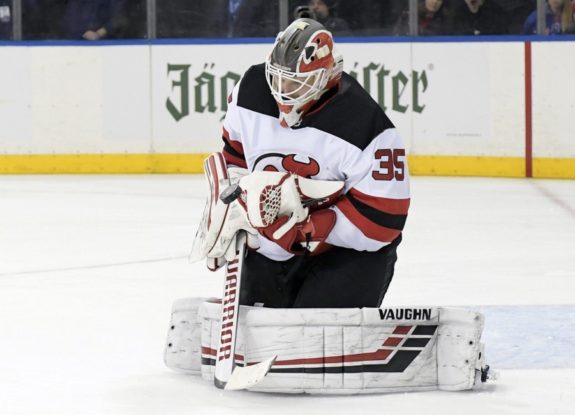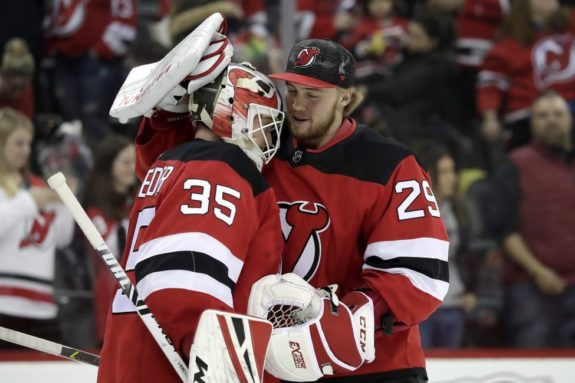Goaltending can define an NHL team’s success. Just ask the Carolina Hurricanes, who were submarined by poor performances in net for years until Petr Mrazek and Curtis McElhinney led them to their first playoff appearance since 2008-09. Things can also go the other way as great goaltending can mask a team filled with flaws (the 2013-14 Colorado Avalanche and 2012-13 Toronto Maple Leafs come to mind).
The New Jersey Devils have experienced the best of both worlds over the last two seasons. Cory Schneider and Keith Kinkaid helped lead them to the playoffs in 2017-18 for the first time since their Stanley Cup run in 2012. But the script flipped a year later, with the team finishing in the bottom five in save percentage (SV%).
Not all was lost, however, as Schneider regained his form in the second half of 2018-19, while Mackenzie Blackwood emerged as a potential goaltender of the future. The Devils need that to carry over into 2019-20, or they could be staring at the NHL’s basement once again, even after an active summer.
Schneider’s Whirlwind Campaign
Schneider’s had a tough go with the Devils over the last few years. He hasn’t finished with an SV% above .910 since 2015-16, with it declining in each of the last three seasons. And 2018-19 may have been one of his most challenging ones yet, with injuries playing a large part in his struggles.
He missed the start of game action after undergoing offseason surgery to repair a hip issue that had been bothering him since 2016-17. When he returned to play, he struggled mightily, posting a .862 SV% in his first nine starts back. The injury bug would strike again as he’d hit injured reserve with an abdominal strain. That forced him to miss the next month-plus of play, but things would be different when he returned in mid-January.

The Devils were well out of the playoff picture by then, but Schneider still had something to prove. Blackwood was playing well, but even then, the team still needed someone to back him up moving forward. And with Schneider signed through 2021-22 at $6 million per year, it was unlikely he was going anywhere. He needed to play well, and that’s what he did.
The wins weren’t there, but Schneider posted some of his best results in a long time. He had a .921 SV% over his final fifteen starts, with one shutout, and finished with a .920 SV% or higher in 10 of those 15 starts. He also had a five-on-five SV% of .926, ranking him ahead of names such as Marc-Andre Fleury, Frederik Andersen, and Carey Price.
Related: Devils 2019-20 Roster: Constructing the Blue Line
Sometimes the numbers can be a bit misleading, but Schneider’s play seemed to coincide with his stats. His side-to-side movement was better, and he looked much quicker than he did before his second stint on injured reserve. That led to him being one of the few bright spots in what was a difficult season for the Devils.
Blackwood Made a Name for Himself
Blackwood wasn’t someone I had pegged for an NHL debut before the start of last season. He struggled in 2017-18, posting a .882 SV% in 32 AHL games, and even saw a demotion to the ECHL by season’s end. It looked like he had a long way to go in his development, but things started looking up in 2018-19.
He got off to a strong start in the AHL, at one point having an SV% as high as .930. Even with his strong performance, there wasn’t room for him in the NHL. But Schneider’s injuries, along with Kinkaid’s struggles, opened the door for Blackwood to play with the big club. He made his first start on Dec. 20, 2018, against the Columbus Blue Jackets and stopped 38/39 shots in a losing effort.

There was pretty much no looking back for Blackwood from that point on. He had a brief stint in the minors once Schneider returned from IR, but he was recalled soon after the Devils moved Kinkaid to the Blue Jackets at the Trade Deadline. Once he returned, he picked up right where he left off.
Blackwood finished the season with a .918 SV% over 21 starts. His five-on-five SV% of .927 ranked him ahead of goalies such as Carey Price, Braden Holtby, and Sergei Bobrovsky. He has the frame, at 6-foot-4, 225 pounds, to be a top goalie in the NHL. With that said, it’s a small sample size to say he’ll be a star goalie with certainty.
Related: Devils 2019-20 Roster: What Are the Lines Going to Look Like
His AHL numbers aren’t particularly impressive as he’s never finished with an SV% higher than .908. But AHL results aren’t always an indicator of NHL success. What is impressive, however, is how he performed on what was an injury-riddled Devils’ team, which had makeshift lineups throughout the second half of the season.
That didn’t seem to affect Blackwood much, though, as he had an SV% of .920 or higher in 11 of his 21 starts. With a much-improved roster heading into training camp, he should still be able to find success, especially if the newly-acquired P.K. Subban bounces back to anchor the team’s blue line.
What Defines Success for Devils’ Goalies?
The Devils’ team SV% of .895 was fourth-worst in the league in 2018-19, even with the way Blackwood and Schneider played down the stretch, and it was below the league average of .905%. The good news is that’s quite the drop from 2017-18, where the league average SV% was .912%. Does that mean goalies are getting worse? Well, not quite.
Most teams are figuring out how to create better shots and scoring chances, which has led to an increase in goal scoring. Led by Nikita Kucherov’s 128 points, six players finished with 100 points or more, while 28 finished with 80 or more. That’s a sharp uptick from 2015-16 when only five players finished with 80 or more points.

With the league looking to create more offense, this isn’t a trend that will slow down any time soon. And that’s especially true with the game beginning to cater to smaller, faster, and younger players. Assuming the league average hovers between .905-.910 for the foreseeable future, the Devils may not need a goalie posting an SV% above .920, although, it can’t hurt.
Schneider and Blackwood don’t need to be stars. But their goaltending cannot rank fourth-worst in the league. The Devils’ offense should see improvement with the additions of Nikita Gusev and Jack Hughes, as well as a healthy Taylor Hall. The defense has question marks, but a bounce-back effort from Subban would go a long way.
If Schneider and Blackwood can give the team above-average goaltending (say around .910-.915), the Devils should fare much better. They showed glimpses of what they could be as a tandem to close out last season, and that’s what the team needs to become relevant again. Anything else, and it could be another disappointing finish in the NHL standings.
* * *
Advanced stats from Natural Stat Trick